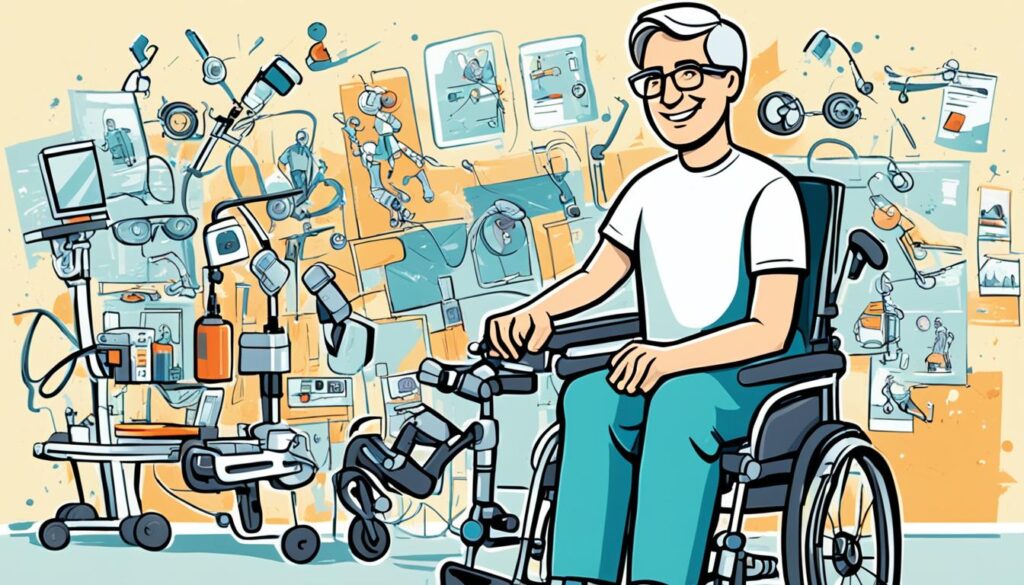If you or a loved one are living with spinocerebellar ataxia, you may be wondering about the available treatment options to manage its symptoms. While there is no cure for this progressive neurological condition, there are strategies that can help improve your quality of life.
In this article, we will explore different treatment options for spinocerebellar ataxia and discuss how they can assist in managing symptoms. From medications to therapies and adaptive devices, there are various approaches that can be tailored to your specific needs.
Discover the possibilities for managing spinocerebellar ataxia and find the support you need to navigate this condition. Let’s delve into the treatment options available for spinocerebellar ataxia and empower you to take control of your health.
Table of Contents
ToggleUnderstanding Spinocerebellar Ataxia
Spinocerebellar ataxia is a group of genetic disorders characterized by the degeneration of the cerebellum and its connections. It can be caused by various genetic mutations and inheritance patterns. The symptoms of spinocerebellar ataxia include difficulties with balance and coordination, unsteady gait, speech difficulties, and involuntary eye movements.
Spinocerebellar ataxia is a complex condition that affects the central nervous system, specifically the cerebellum. The cerebellum plays a crucial role in coordinating movement and balance. When the cerebellum degenerates, it disrupts the communication between the brain and the muscles, leading to the symptoms of ataxia.
There are different types of spinocerebellar ataxia, each associated with a specific genetic mutation. The inheritance of spinocerebellar ataxia can be autosomal dominant, autosomal recessive, or X-linked. In autosomal dominant inheritance, a child has a 50% chance of inheriting the mutated gene if one of the parents carries it. Autosomal recessive inheritance requires both parents to be carriers of the mutated gene, resulting in a 25% chance of a child inheriting the condition. X-linked inheritance affects males more frequently, as the mutation occurs on the X chromosome.
Symptoms of Spinocerebellar Ataxia
The symptoms of spinocerebellar ataxia can vary depending on the type of genetic mutation and the progression of the disease. Common symptoms include:
- Difficulties with balance and coordination, leading to unsteady movements
- Speech difficulties, such as slurred or slow speech
- Involuntary eye movements, including jerking or difficulty focusing
- Muscle stiffness and rigidity
- Tremors or shaking
As spinocerebellar ataxia progresses, these symptoms may worsen and impact daily activities, making it difficult to perform tasks such as walking, writing, and speaking.
Causes of Spinocerebellar Ataxia
Spinocerebellar ataxia is primarily caused by genetic mutations that affect the structure and function of the cerebellum. These mutations can occur in different genes, resulting in different types of spinocerebellar ataxia.
The specific genes involved in spinocerebellar ataxia vary depending on the type of the condition. For example, spinocerebellar ataxia type 1 is caused by a mutation in the ATXN1 gene, while spinocerebellar ataxia type 3 is caused by a mutation in the ATXN3 gene.
Research is ongoing to better understand the molecular mechanisms underlying spinocerebellar ataxia and to identify potential targets for treatment and intervention.
| Type of Spinocerebellar Ataxia | Associated Gene Mutation | Inheritance Pattern |
|---|---|---|
| Spinocerebellar ataxia type 1 | ATXN1 | Autosomal dominant |
| Spinocerebellar ataxia type 2 | ATXN2 | Autosomal dominant |
| Spinocerebellar ataxia type 3 | ATXN3 | Autosomal dominant |
| Spinocerebellar ataxia type 6 | CACNA1A | Autosomal dominant |
| Spinocerebellar ataxia type 7 | ATXN7 | Autosomal dominant |
| Spinocerebellar ataxia type 10 | ATXN10 | Autosomal dominant |
This table provides an overview of some common types of spinocerebellar ataxia and their associated gene mutations and inheritance patterns.
Diagnosing Spinocerebellar Ataxia
Diagnosing spinocerebellar ataxia involves a comprehensive evaluation conducted by healthcare professionals. The process typically begins with a thorough physical and neurological examination. During the examination, your doctor will assess your coordination, balance, reflexes, and muscle strength.
To further investigate the condition and rule out other potential causes, additional diagnostic tests may be conducted. These tests can help identify any underlying factors contributing to the development of spinocerebellar ataxia and provide a more accurate diagnosis. Some common diagnostic tests for spinocerebellar ataxia include:
- Blood tests: Blood tests can help determine if there are any abnormalities in your blood that may be associated with spinocerebellar ataxia. These tests can detect specific genetic mutations, assess the functioning of different organs, and evaluate nutrient levels.
- Imaging studies: Imaging studies, such as magnetic resonance imaging (MRI), may be conducted to examine the brain and spinal cord for any structural abnormalities or changes. This can help identify any areas of degeneration in the cerebellum and its connections.
- Genetic testing: Genetic testing is an essential component of diagnosing spinocerebellar ataxia. It involves analyzing your DNA to identify specific genetic mutations associated with spinocerebellar ataxia. This test can help determine the specific type of spinocerebellar ataxia you have and provide valuable information for personalized treatment decisions.
Genetic testing plays a crucial role in understanding the inheritance pattern of spinocerebellar ataxia as well. It helps determine if the condition is inherited and whether you may pass it on to your children.
It’s important to note that diagnosing spinocerebellar ataxia can be complex due to the wide range of genetic mutations and the similar symptoms it shares with other neurological disorders. Therefore, a multidisciplinary approach involving specialized healthcare professionals, such as neurologists and geneticists, is often necessary.
| Diagnostic Tests for Spinocerebellar Ataxia | Purpose |
|---|---|
| Blood tests | To detect genetic mutations, assess organ functioning, and evaluate nutrient levels |
| Imaging studies (MRI) | To examine the brain and spinal cord for structural abnormalities or changes |
| Genetic testing | To analyze DNA and identify specific genetic mutations associated with spinocerebellar ataxia |
By utilizing these diagnostic tools, healthcare professionals can accurately diagnose spinocerebellar ataxia and provide personalized treatment plans based on your specific condition and needs.
Treatable Causes of Spinocerebellar Ataxia
In some cases, spinocerebellar ataxia may be caused by treatable underlying conditions. Identifying and addressing these causes can lead to improvements in symptoms and the overall management of ataxia. Some of the treatable causes of spinocerebellar ataxia include:
Vitamin Deficiencies
Vitamin deficiencies, such as deficiencies in vitamins E, B12, and thiamine, can contribute to the development or worsening of spinocerebellar ataxia. Ensuring an adequate intake of these vitamins or receiving supplements under medical supervision can help improve symptoms and promote overall neurological health.
Infections
Certain infections, such as Lyme disease or viral infections like human immunodeficiency virus (HIV) and Epstein-Barr virus (EBV), can also trigger or exacerbate spinocerebellar ataxia. Prompt and appropriate treatment of these infections can potentially reverse or slow down the progression of ataxia.
Medications
Some medications, known as ototoxic drugs, have been associated with secondary ataxia. These medications may include certain antibiotics, antiepileptic drugs, and some types of chemotherapy. If medication-induced ataxia is suspected, consultation with a healthcare professional is essential to assess the potential for changing or adjusting medications.
Metabolic Disorders
Metabolic disorders, such as Wilson’s disease or thiamine-responsive megaloblastic anemia, can present with ataxia as a symptom. Prompt diagnosis and appropriate management of these underlying metabolic conditions are crucial in preventing further complications and optimizing outcomes for individuals with spinocerebellar ataxia.
Autoimmune Conditions
Some autoimmune conditions, including gluten ataxia and paraneoplastic cerebellar degeneration, can cause secondary ataxia. Identifying and effectively managing these autoimmune conditions through medication and lifestyle modifications can potentially improve ataxia symptoms.
It is important to note that the specific treatment approach will depend on the underlying cause identified through thorough diagnostic evaluations. Proper medical assessment by a healthcare professional is essential to determine the appropriate course of action for individuals with spinocerebellar ataxia.
| Treatable Causes of Spinocerebellar Ataxia | Description |
|---|---|
| Vitamin Deficiencies | Deficiencies in vitamins E, B12, and thiamine |
| Infections | Infections like Lyme disease, HIV, and EBV |
| Medications | Use of certain ototoxic drugs |
| Metabolic Disorders | Underlying metabolic conditions like Wilson’s disease |
| Autoimmune Conditions | Autoimmune conditions such as gluten ataxia |
Medications for Spinocerebellar Ataxia
If you have been diagnosed with spinocerebellar ataxia, there are medications available that can help manage your symptoms and improve your quality of life. One such medication is riluzole. This drug has shown promising results in improving functional measures in SCA patients. It works by reducing the excitotoxicity caused by the excessive release of glutamate in the brain.
| Medication | Uses | Potential Benefits |
|---|---|---|
| Riluzole | Reduces glutamate toxicity | Improvement in functional measures |
| Varenicline | Nicotinic receptor agonist | Potential improvement in ataxic symptoms |
| Buspirone | Anxiolytic and anti-depressant | Potential improvement in ataxic symptoms |
It is important to note that the effectiveness of these medications may vary from person to person, and they may not be suitable for everyone. Your healthcare provider will consider your individual circumstances and medical history before recommending any specific medication. It is always recommended to consult with a healthcare professional for guidance on the most appropriate drug treatments for your spinocerebellar ataxia.

Therapies for Spinocerebellar Ataxia
In addition to medications, various therapies can help individuals with spinocerebellar ataxia manage their symptoms and improve their quality of life. Physical therapy, occupational therapy, and speech therapy are commonly used to address the specific needs of individuals with spinocerebellar ataxia.
Physical Therapy for Spinocerebellar Ataxia
Physical therapy plays a crucial role in the management of spinocerebellar ataxia. It focuses on improving balance, coordination, and muscle strength through tailored exercises and rehabilitation techniques. A physical therapist will work closely with you to design a personalized exercise program that targets your specific needs and helps optimize your physical function.
Occupational Therapy for Spinocerebellar Ataxia
Occupational therapy is aimed at helping individuals with spinocerebellar ataxia maintain their independence in daily living activities. An occupational therapist will assess your functional abilities and develop strategies to enhance your ability to perform self-care tasks, such as dressing, feeding, and bathing. They may also recommend adaptive equipment and modifications to your home environment to maximize safety and accessibility.
Speech Therapy for Spinocerebellar Ataxia
Speech and swallowing difficulties are common symptoms of spinocerebellar ataxia. Speech therapy can help improve communication skills, enhance speech clarity, and address swallowing difficulties. A speech therapist will provide specialized exercises and techniques to strengthen the muscles involved in speech production and swallowing, enabling you to communicate more effectively and reduce the risk of aspiration.
| Therapy Type | Goals | Benefits |
|---|---|---|
| Physical Therapy | Improve balance, coordination, and muscle strength | Enhanced physical function and reduced fall risk |
| Occupational Therapy | Enhance independence in daily living activities | Improved quality of life and increased self-reliance |
| Speech Therapy | Improve speech clarity and swallowing function | Effective communication and reduced risk of aspiration |
Adaptive Devices and Assistive Technology
Adaptive devices and assistive technology are invaluable tools for individuals with spinocerebellar ataxia, offering support and enhancing their ability to carry out daily activities. These devices are designed to compensate for the limitations caused by ataxia, promoting independence and improving overall quality of life.
Examples of Adaptive Devices
There are various adaptive devices available that cater to different needs specific to spinocerebellar ataxia. Here are some examples:
- Walking aids: Mobility aids such as canes, walkers, and rollators provide stability and support while walking, reducing the risk of falls and promoting safe movement.
- Modified utensils: Eating can be challenging for individuals with ataxia due to impaired hand control and coordination. Specialized utensils with ergonomic handles or custom grips can make self-feeding easier and more manageable.
- Communication aids: Ataxia can affect speech and communication. Augmentative and alternative communication (AAC) devices, such as speech-generating devices or communication apps, enable individuals to express themselves effectively and engage in conversations.
These adaptive devices are designed to accommodate the specific needs and challenges faced by individuals with spinocerebellar ataxia, enabling them to maintain their independence and participate actively in daily life.

Assistive Technology for Spinocerebellar Ataxia
Assistive technology offers a wide range of tools and devices that aid individuals with ataxia in performing specific tasks. These technologies are designed to compensate for motor and functional impairments, facilitating greater accessibility and inclusivity.
Some examples of assistive technology for spinocerebellar ataxia include:
- Voice-activated smart devices: Artificial intelligence-powered voice assistants, such as Amazon Echo or Google Home, can be programmed to control various home devices, make phone calls, set reminders, and perform other tasks with voice commands, reducing the reliance on manual interaction.
- Smart home automation systems: These systems integrate and automate various household functions, such as lighting, temperature control, and security, allowing individuals to control their environment more easily using voice commands or mobile applications.
- Computer accessibility software: Software programs like voice recognition software, screen reading software, and adaptive keyboards can enable individuals with ataxia to navigate computers, access the internet, and perform tasks efficiently.
Assistive technology empowers individuals with ataxia to overcome barriers and actively participate in various aspects of life. It enhances their ability to communicate, perform tasks, and access information, fostering independence and promoting a higher level of engagement.
| Benefits of Adaptive Devices and Assistive Technology | Benefits of Adaptive Devices and Assistive Technology |
|---|---|
| Enhanced mobility and independence | Improved communication and social interaction |
| Increased safety and reduced risk of falls | Greater access to information and resources |
| Facilitates participation in daily activities | Enhanced productivity and task performance |
| Promotes overall well-being and quality of life | Ensures inclusivity and equal opportunities |
Clinical Trials and Experimental Treatments
Researchers are constantly exploring new treatment options for spinocerebellar ataxia through clinical trials and experimental therapies. These trials investigate the safety and efficacy of novel medications, gene therapies, and other interventions. Participating in clinical trials can provide access to potentially groundbreaking treatments.
Clinical trials serve as a vital platform for evaluating the effectiveness of innovative approaches in managing spinocerebellar ataxia. These trials involve rigorous testing to ensure the safety of experimental treatments and gather data about their potential benefits. By participating in clinical trials, you have the opportunity to contribute to the advancement of research and gain access to cutting-edge therapies that may not yet be available to the general public.
Experimental treatments for spinocerebellar ataxia may include gene therapies aimed at targeting specific genetic mutations responsible for the condition. These therapies involve the delivery of modified genes to correct or compensate for the underlying genetic defect. While they are still in the investigational stage, gene therapies hold great promise in addressing the root cause of spinocerebellar ataxia.
In addition to gene therapies, other investigational therapies for spinocerebellar ataxia encompass a wide range of innovative approaches. These may involve targeting specific molecules or pathways in the brain to modulate or slow down the progression of the disease. Experimental medications, neuroprotective agents, and stem cell therapies are among the avenues being explored to develop more effective treatments.
It’s important to note that participation in clinical trials is entirely voluntary, and each trial has specific eligibility criteria. Before considering participation, it’s advisable to consult with your healthcare provider to understand the potential risks and benefits associated with a particular trial. Your healthcare provider can guide you in exploring the available clinical trial options and help you make an informed decision.
Coping with Spinocerebellar Ataxia
Living with spinocerebellar ataxia can be challenging, both for individuals with the condition and their loved ones. Fortunately, there are various ways to cope with the emotional and physical aspects of the disease. Seeking support through counseling or joining support groups can provide a valuable outlet for sharing experiences and receiving guidance from others who understand what you’re going through.
Emotional support is crucial in managing the mental health impact of spinocerebellar ataxia. It’s normal to experience a range of emotions, including frustration, sadness, and anxiety. Speaking with a therapist or counselor who specializes in neurological conditions can help you navigate these emotions and develop coping strategies.
Support groups can also offer a sense of community and connection. Interacting with individuals who share similar experiences can provide a space to share tips, insights, and encouragement. It can be empowering to learn from others who have successfully navigated the challenges of spinocerebellar ataxia.
Lifestyle Modifications for Spinocerebellar Ataxia
In addition to emotional support, making certain lifestyle modifications can enhance your overall well-being when living with spinocerebellar ataxia.
Maintaining a healthy diet: Eating a nutritious diet can help support your energy levels and overall health. A diet rich in fruits, vegetables, whole grains, and lean proteins can provide essential nutrients and promote optimal well-being. Consult a registered dietitian who can help tailor a diet plan specific to your needs.
Staying active: Engaging in regular physical activity, within the limits of your abilities, can have numerous benefits. Exercise can help improve balance, coordination, and muscle strength. Consult a physical therapist who can develop a personalized exercise plan that takes into consideration your individual needs and capabilities.
Adapting your environment: Making modifications to your home environment can help optimize your safety and mobility. Removing obstacles, installing handrails, and adding nonslip surfaces can help prevent falls and minimize accidents.
Assistive devices: Utilizing assistive devices can support your independence and make daily tasks easier. Walking aids, such as canes or walkers, can provide stability and improved mobility. Modified utensils and adaptive equipment can assist with tasks like eating, dressing, and bathing.
By incorporating these lifestyle modifications and seeking the right support, you can enhance your quality of life while coping with spinocerebellar ataxia.

Future Directions in Spinocerebellar Ataxia Treatment
Exciting advancements in genetic research and our understanding of the underlying mechanisms of spinocerebellar ataxia are paving the way for future treatments. Researchers and scientists are exploring various innovative approaches to develop more effective therapies and improve the lives of individuals with this condition.
Gene Editing Techniques
One promising avenue of research is the use of gene editing techniques to address the underlying genetic mutations that cause spinocerebellar ataxia. Technologies like CRISPR-Cas9 have shown potential in correcting the faulty genes responsible for the condition, offering hope for targeted and personalized treatments.
Stem Cell Therapy
Another area of exploration is stem cell therapy, which involves using stem cells to repair or replace damaged cells in the cerebellum. By harnessing the regenerative potential of stem cells, researchers aim to restore normal function and slow down the progression of spinocerebellar ataxia.
Neuroprotective Agents
Neuroprotective agents are being studied for their potential to prevent or minimize the degeneration of neurons in the cerebellum. These agents aim to protect the brain cells from further damage, potentially slowing down the progression of spinocerebellar ataxia and preserving neurological function.
The development of these and other emerging therapies offers hope for improved outcomes and a better quality of life for individuals living with spinocerebellar ataxia. While these treatments are still in the experimental stage, they hold great promise for the future.
Conclusion
Although there is no cure for spinocerebellar ataxia, there are treatment options available that can help manage symptoms and improve the quality of life for individuals with the condition. The multidisciplinary approach, involving medications, therapies, and assistive devices, plays a vital role in providing comprehensive care and support.
Medications such as riluzole have shown promising results in improving functional measures for spinocerebellar ataxia patients. Therapies like physical therapy, occupational therapy, and speech therapy can assist in managing symptoms and enhancing daily functioning. Additionally, adaptive devices and assistive technology enable individuals to maintain independence and improve their daily lives.
Looking to the future, ongoing research and clinical trials bring hope for new and more effective treatments. Advances in genetic research, including gene editing techniques and stem cell therapy, hold promise for the development of groundbreaking treatment options. It is an exciting time for the spinocerebellar ataxia community as advancements continue to be made.
FAQ
What is spinocerebellar ataxia?
Spinocerebellar ataxia is a neurological condition that affects coordination and balance. It is characterized by the degeneration of the cerebellum and its connections, caused by various genetic mutations and inheritance patterns.
What are the symptoms of spinocerebellar ataxia?
The symptoms of spinocerebellar ataxia include difficulties with balance and coordination, unsteady gait, speech difficulties, and involuntary eye movements.
How is spinocerebellar ataxia diagnosed?
Spinocerebellar ataxia is typically diagnosed through a thorough physical and neurological examination. Additional tests, such as blood tests and imaging studies, may be conducted to identify underlying causes or detect changes in the brain. Genetic testing is also recommended to determine the specific type of spinocerebellar ataxia.
Can spinocerebellar ataxia be caused by treatable underlying conditions?
Yes, in some cases, spinocerebellar ataxia may be caused by treatable underlying conditions such as vitamin deficiencies or infections. Treating these underlying causes can help improve symptoms.
Are there medications available for spinocerebellar ataxia?
Yes, there are medications available that can help manage the symptoms of spinocerebellar ataxia. Riluzole is one such medication that has shown promising results in improving functional measures in SCA patients. Other medications, such as varenicline and buspirone, have also been studied for their potential benefits in treating ataxia.
What therapies are available for spinocerebellar ataxia?
Various therapies can help individuals with spinocerebellar ataxia manage their symptoms and improve their quality of life. Physical therapy can assist with balance and coordination exercises, while occupational therapy focuses on daily living tasks. Speech therapy may also be beneficial for individuals with speech and swallowing difficulties.
How can adaptive devices and assistive technology help with spinocerebellar ataxia?
Adaptive devices and assistive technology can play a significant role in helping individuals with spinocerebellar ataxia maintain their independence and improve their daily functioning. Examples of adaptive devices include walking aids, modified utensils, and communication aids.
Are there any clinical trials or experimental treatments for spinocerebellar ataxia?
Yes, researchers are constantly exploring new treatment options for spinocerebellar ataxia through clinical trials and experimental therapies. These trials investigate the safety and efficacy of novel medications, gene therapies, and other interventions.
How can individuals cope with spinocerebellar ataxia?
It’s important to seek support through counseling or support groups to cope with the emotional and physical aspects of the disease. Lifestyle modifications, such as maintaining a healthy diet and staying physically active, can also contribute to overall well-being.
What are the future directions in spinocerebellar ataxia treatment?
Advances in genetic research and understanding of the underlying mechanisms of spinocerebellar ataxia hold promise for future treatment options. Gene editing techniques, stem cell therapy, and neuroprotective agents are among the potential avenues being explored to develop more effective treatment options.
Can spinocerebellar ataxia be cured?
Currently, there is no cure for spinocerebellar ataxia. However, there are treatment options available that can help manage symptoms and improve the quality of life for individuals with the condition.
About The Author

This article is medically reviewed by Dr. Chandril Chugh, Board-Certified Neurologist, providing expert insights and reliable health information.
Dr. Chandril Chugh is a U.S.-trained neurologist with over a decade of experience. Known for his compassionate care, he specializes in treating neurological conditions such as migraines, epilepsy, and Parkinson’s disease. Dr. Chugh is highly regarded for his patient-centered approach and dedication to providing personalized care.
→ Book a consultation to discover which remedies suit your needs best.




